
Signs of a city remade emerge at Ground Zero
9/11/2011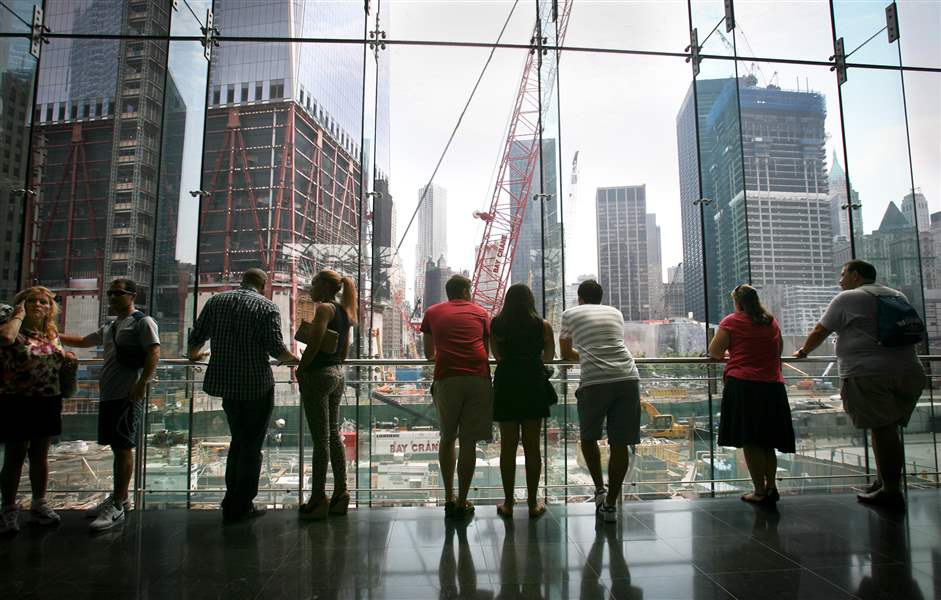
The view from the World Financial Center eastward shows a revitalized Ground Zero.
McClatchy Newspapers
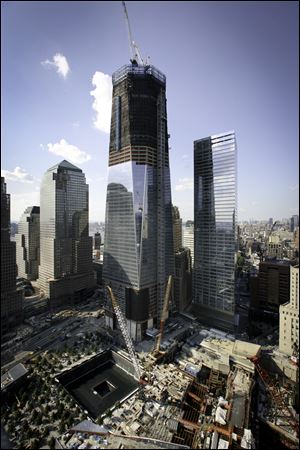
One World Trade Center and Seven World Trade Center rise adjacent to the site where the twin towers stood.
NEW YORK -- In this place, hallowed when two planes ripped a hole in the skyline, scarring a city that prides itself on its emotionally unassailable citizenry, 9/11 is an old hurt. But the hurt is receding as the community in the shadows of Ground Zero is reforged.
Near where the twin towers once stood, skeletal scaffolding, the tangle of cranes, and gleaming half-finished skyscrapers arch heavenward from the freshly upturned earth.
This dream of rebirth is as bold and ambitious as its developer, a native New Yorker whose creation has lured big-name firms back to lower Manhattan. It may prove out of reach for some who have spent the past decade waiting for
Ground Zero to reawaken.
In this moment, the neighborhood's sepia-toned, once largely abandoned apartment blocks have been remade in Technicolor. Small children amble across carefully crafted bits of green space, and well-heeled Manhattanites sip cocktails on eco-friendly roof decks.
A centuries-old church hewn from plaster and stone opens its doors wide on Sunday mornings to pilgrims who have come to grieve, rejoice, and remember.
This is the new city where brick, stone, and steel endure and form a new horizon.
The developer
From his perch high within 7 World Trade Center, developer Larry Silverstein witnesses the resurrection of Ground Zero.
The raw maw of construction surrounding the site stretches wide below him as architectural symmetry and order are cleaved from a decade of legal, political, and emotional chaos.
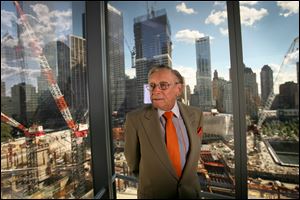
Developer Larry Silverstein assembled a team of some of the world's most-renowned architects to resurrect the World Trade Center site in Manhattan.
His vision takes shape from an office where a painting of a storm-tossed ship hangs on a wall.
"It was the passion of my life to get this thing rebuilt," Mr. Silverstein said.
Ground Zero was still a smoldering mound, the smell of ash and char still thick in the air, when Mr. Silverstein began to envision its rebirth. He worried that Lower Manhattan would become a mausoleum, sending a message that the terrorists had won. To the Brooklyn-born Mr. Silverstein, that was unacceptable.
He assembled a team of some of the world's most-renowned architects. Their work drew inspiration from the contemplative stillness near the obsidian-colored Ground Zero memorial, the Hudson River's silver waters, and the bone-colored clouds reflected in soaring panes of glass.
Over an electrical substation capable of powering all of Lower Manhattan, he built a tall, shiny tower: lucky number seven.
To date it is the only completed World Trade Center building. He peopled it with multimillion-dollar companies, a sophisticated group armed with glossy public relations materials and a motley crew of artists charged with chronicling Ground Zero's progress.
Perhaps less poetically, he also assembled a team of lawyers for a years-long legal battle with insurers over the amount of coverage needed for the rebuilding of the destroyed World Trade Center site.
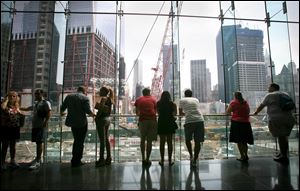
The view from the World Financial Center eastward shows a revitalized Ground Zero.
To some New Yorkers he is Orpheus on a quest to bring a beloved New York neighborhood back from the dead.
To others he is Midas obsessed with building gilded castles.
In either case, he was what this city needed: a reminder of that quintessentially New York spirit of resilience.
"This is the best New York has to offer," Mr. Silverstein said of the rebuilding efforts. "This is reflective of New Yorkers' resolve. The terrorists had to be denied their quest."
Exactly one month before today's 10-year anniversary of the attacks, before thousands of family members journeyed to Ground Zero to remember the loved ones they lost so many years ago, Mr. Silverstein thought about the seductive lure of memory.
New York is a city filled with history's phantoms. It would be easy to muse along the banks of the river or stare at soaring glass edifices and get lost in reflection.
But sometimes the harder thing is to put shovel to earth, take a deep breath, and dig.
Standing her ground
Celeste Lee watches from her apartment windows as the empty space in lower Manhattan's skyline slowly is filled in.
Seven World Trade Center shimmers and gleams in the late summer sun. Beside it, One World Trade Center spirals upward.
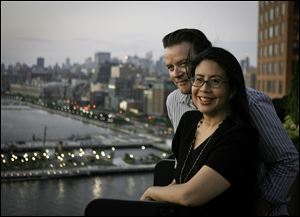
Celeste Lee and Gerald Janssen decided to remain in the neighborhood near Ground Zero after the attacks, even when a representative from the Federal Emergency Management Agency told her, 'You shouldn't be here. None of us should be here.'
Sometimes it seems as if they are so close that if she just closes her eyes for a moment, things can be as they were before.
Before she watched in horror from her apartment terrace as planes crashed into the twin towers, and she fled clutching her husband's hand, photos, and two bottles of Pellegrino water, unsure of where she'd end up.
Before melted glass and metal coated her neighborhood in an eerily beautiful silver-and-gold dust, later replaced by ash and a smell that lingered no matter how many times she washed the sheets.
Before the neighborhood near Ground Zero became a ghost town and the government decided to try to lure settlers back to the area with housing subsidies.
In this re-envisioned city, Ms. Lee, the owner of a beauty and fashion consulting firm, and the others who refused to leave were the pioneers.
She stayed even when a representative from the Federal Emergency Management Agency told her, "You shouldn't be here. None of us should be here" -- and then handed her a white painter's mask.
The inside of the mask was gray with soot by day's end. A year later the Environmental Protection Agency finally sent someone to clean her apartment.
But she and her husband, Gerald Janssen, stayed because this was their bit of New York.
There was camaraderie in their hardscrabble post-9/11 existence. There was a sense of communal understanding when she pressed bills into her dry cleaner's palm or bought fresh croissants from the local baker. Their neighborhood's tenuous survival depended on the unspoken promise to see things through.
"To leave would have been like quitting," she said. "It didn't seem like the right thing to do."
The little French bakery is gone. So too are so many of the mom-and-pop businesses -- holdouts that were priced out of the community by skyrocketing rents.
Her new neighbors have jobs with six-figure incomes at companies in Seven World Trade and other businesses that have set up shop in this once-forgotten corner of the city. They shop at the gourmet supermarket, jog along the carefully sculpted harbor-front paths, and take their children to play in Rockefeller Park.
Her own rent has gone up several times, and she expects another increase when magazine publishing giant Conde Nast moves thousands of employees into One World Trade Center. She too may be priced out of the neighborhood.
"The sense of community that existed in 2001 and 2002 has gone away. The shared experience is no longer there," Ms. Lee said. "But perhaps this is the march of society."
The church
From St. Paul's Chapel doors, flung wide to greet the early-morning light, Ground Zero is a place at peace.
The seemingly constant hum, clank, and groan of machinery is silenced for a few hours on Sundays.
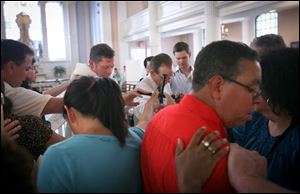
The Rev. Clayton Crawley leads a service at St. Paul's Chapel near Ground Zero. Tourists from all over the world flock by the hundreds each month to pay homage to the church that stood when far mightier buildings tumbled behind it.
The Rev. Clayton Crawley drinks in the hush as he dons his robes. He smiles gently as the four choir members' voices pierce the stillness and a wisp of incense curls and twists in on itself before fading in the breeze.
He takes a moment before stepping into the small cluster of worshippers in the center of the chapel to glance at the swirl of onlookers.
They are tourists from all over the world, who flock by the hundreds each month to pay homage to the church that stood when far mightier buildings tumbled behind it, offering the first responders respite in its pews.
"We reached a crossroads, and we had a choice when it came to service," Pastor Crawley said later. "We had to decide whether we would shut the doors and keep people out or welcome them."
And so St. Paul's, a historic chapel where President George Washington once worshipped, removed its pews and hung on its walls photos of those who were lost and those who worked to recover the dead.
The pilgrims are respectful as they circumnavigate the room, stopping from time to time to drink in the sermon.
And the pastor, who once performed last rites on Ground Zero's ashen pyre, ministers to the living.
He gently entreats them to rejoice, to lay hands on one another's shoulder, to dance, to sing, because life is beautiful and painful and fleeting.
"It is this moment," he says. "Where we pause only to begin work again."